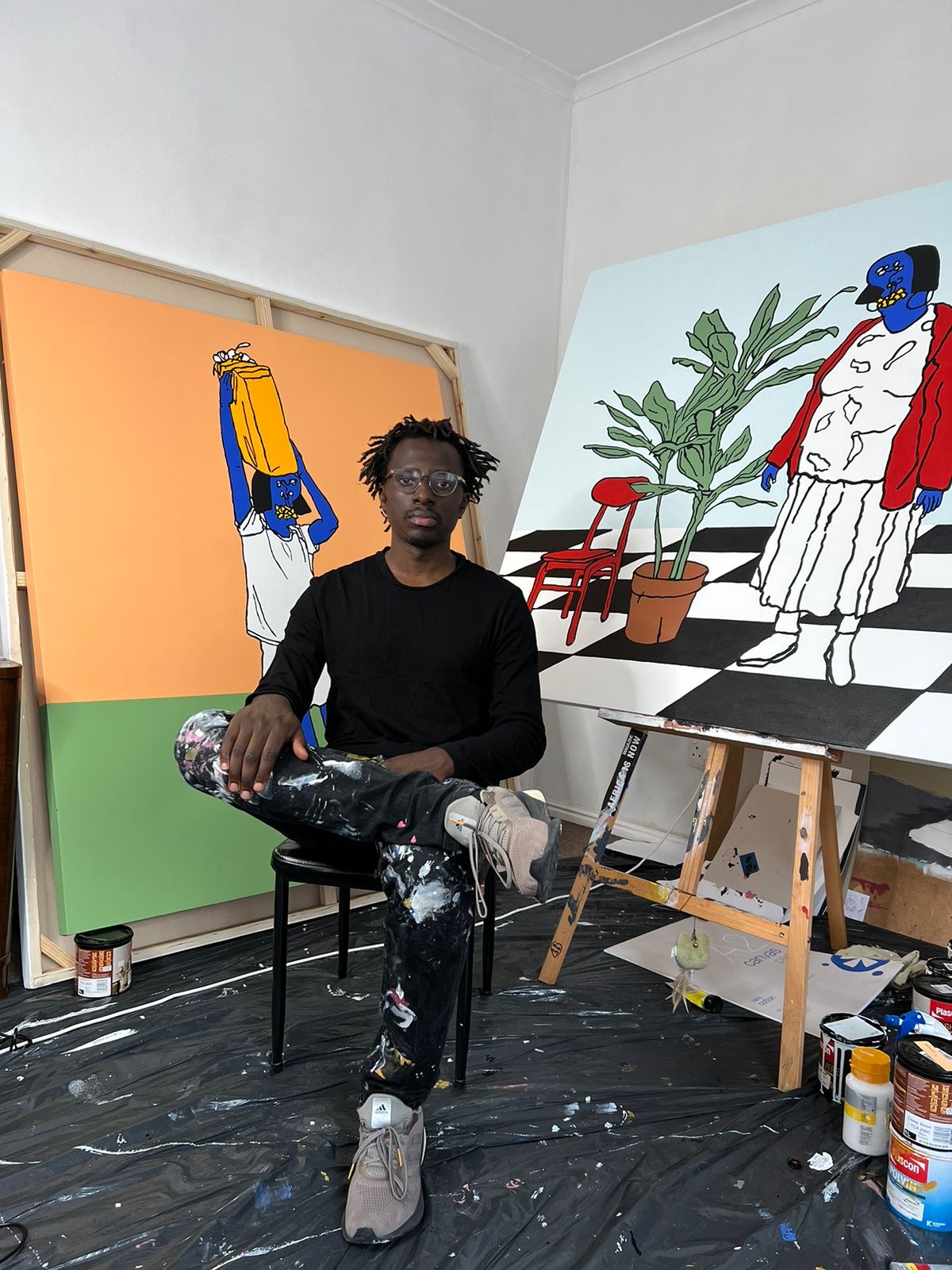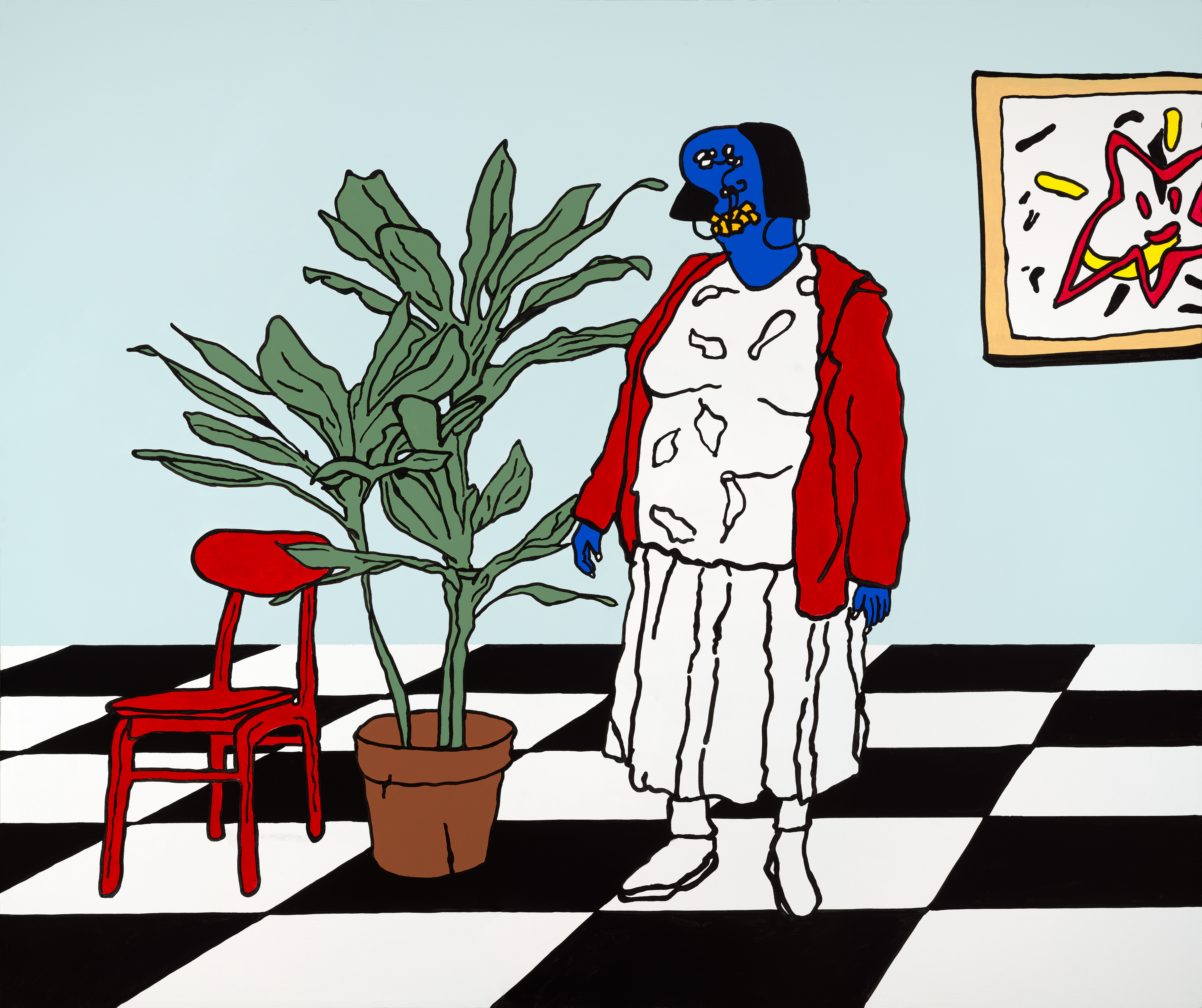Q&A with Rwandan artist Jean Luc Iradukunda
-------------

Jean Luc Iradukunda (b. 1998) is an artist hailing from Gisenyi, Rwanda, whose creative journey primarily revolves around the realm of painting. Drawing inspiration from his own experiences as a Rwandan migrant in modern-day South African society, Iradukunda delves into the intricacies of the everyday aesthetic of the nucleus family, while offering insightful commentary on the human condition.
As an artist, Jean Luc Iradukunda invites us to embark on a journey of self-reflection and empathy. Through his abstract expression and profound symbolism, he challenges us to question the constructs that define us and the societies we inhabit. Iradukunda's art fearlessly explores the complexities of identity, belonging, and home, acting as a bridge between cultures. This serves as a powerful reminder that identity and belonging are multi-layered. By understanding and embracing the diverse narratives of others, we can foster connection and unity on a profoundly human level and appreciate the richness that arises from our collective experiences.
Jean Luc Iradukunda currently lives and works in Cape Town, South Africa.
What inspired you to become a fine artist?
Jean Luc Iradukunda (JLI): Art has been a fundamental part of my life from a young age – it offered a means of both expression and self-discovery. My path toward becoming a fine artist felt both surprising and organic at the same time, less a single decision and more a culmination of where my creative process was tending. This evolution mirrored, perhaps even spurred, a period of personal exploration where I questioned my identity and my place in the world. Painting allowed me to grapple with those internal struggles in a manner I had previously not been able to, it allowed me to transform them into something tangible. So, my journey didn't stem from a lightning bolt of inspiration but rather from the steady pursuit of expressing my self to the best of my artistic abilities at that given time.
Your personal family story is the inspiration for your paintings, can you tell us a bit more about your journey?
(JLI): My work reflects a profound part of my personal and family history, rooted in our experiences both in Rwanda and later, South Africa. Growing up in Rwanda, a close-knit community surrounded us, steeped in a vibrant culture that formed the backdrop for my early life. Migrating to South Africa in search of refuge and a better life was monumental, more than just a change of place – it was a deep shift in every aspect of our lives. This journey from the familiar into completely new and unknown territory profoundly shaped the way I think about the world and my place within it. My work draws from those complexities, this search for belonging within a changed landscape, while still trying to maintain a connection to my Rwandan roots.
How would you describe your artistic style?
(JLI): Experimental.
Why did you choose the blue colour and the semi abstracted approach for your character
(JLI): The choice of blue and a semi-abstracted form for my subjects emerged from my exploration of the human figure. Initially, this direction wasn't planned; it evolved from experimenting with distorting the human form and trying to create a narrative. I later became captivated by the results, particularly how these abstracted, blue, alien-like figures could embody the profound sense of 'othering' that one experiences growing up as a migrant. This approach allowed me to visually articulate the alienation and disconnection experienced in unfamiliar environments, highlighting the emotional and psychological distances these individuals navigate. For me, it just made sense; it was what I felt I had to create.

The abstracted teeth, what is the significant? What does the gold colour represents?
(JLI): The jagged yellow teeth in my pieces act as a device to extend the work’s narrative on human disfigurement. They play on the concept of pareidolia, where even amidst distortion, the essence of humanity persists. These teeth, placed where one expects a mouth, push the boundaries of recognition, yet remind us of the human form.
Are you influenced by fashion trends? How do you chose what your figures are wearing?
(JLI): In other parts of my life yes but for the paintings, the clothes are used as a way to play with concepts of specificity and generalisation. All the clothes have no colour but have specific details that can be used to associate them, like Igetenge (type of African fabric known for its vibrant colours and elaborate patterns). Through the use of distinctive patterns, such as Igetenge, the attire helps bridge individual identities with broader cultural narratives of the works.
Who are your biggest artistic influences? Do you have a mentor?
(JLI): Lately I think a lot about the work of Doris Salcedo, Lynette Yiadom Boakye and Peter Doig.
I’ve had the privilege of working with Brutal Curation through their mentorship receiving invaluable feedback and guidance throughput my creative process.
Does your art reflect or influence societal values or commentary?
(JLI): I would like to think so, my artworks attempt to serve as a mirror to societal values and commentary, particularly through the lens of migration. By documenting the lives and experiences of migrants, my pieces aim to shed light on the universal, yet deeply personal, realities of movement and displacement. Migration is a timeless phenomenon, and through my art, I have the unique opportunity to offer firsthand insights into its nuances. This, I believe, not only reflects but also invites a dialogue on the ever-relevant themes of identity, belonging, seeking refuge, and the human condition across different societies.
How do you handle creative block?
(JLI): When facing a creative block, I dive into a wide array of inspirations, which often involves extensive research. This can include reading, watching films, artist interviews, documentaries, and exploring any art related media available to me. I believe in the idea that immersing oneself in art fills the creative reservoir, much like water in a glass, until it overflows and spills into new creation. This process of constant consumption and reflection helps me break through creative barriers and fosters the emergence of new ideas and experiments.
What challenges have you faced as an artist, and what are your proud moments?
(JLI): Self-doubt, securing enough time to study, practice, and create more art. Another significant hurdle was the material cost of art supplies, which was a steep barrier to entry. It was only by maintaining another job that I could subsidise this practice and continue creating.
On a personal level, sharing my story and thoughts through art has brought immense fulfilment. Professionally, my proudest moments to date include participating in the Investec Cape Town Art Fair and showcasing a solo booth at Scope Miami in 2023.
Further Reading In Articles
African Artist Directory















